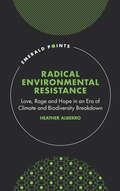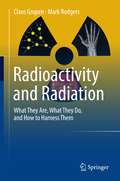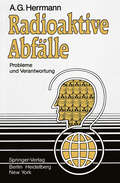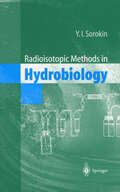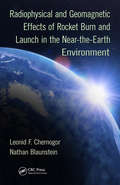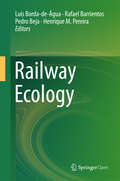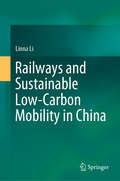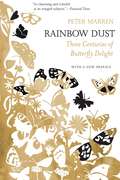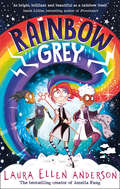- Table View
- List View
Radical Animism: Reading for the End of the World (Environmental Cultures)
by Jemma DeerThe reckoning of climate change calls for us to fundamentally rethink our notions of human centrality, superiority and power. Drawing on a wide range of modern writers and thinkers – from Freud and Darwin to Latour and Derrida, from Shakespeare and Carroll to Woolf and Kafka – Radical Animism develops a new theory of life for a planet in crisis. In this original and timely work, Jemma Deer reframes our thinking of the Anthropocene with ideas from anthropology, astronomy, deconstruction, evolutionary biology, psychoanalysis, quantum physics and veganism. Through readings that are both inventive and compelling, this book shows how 'literary animism' – the active and transformative life of literature – can open our thinking to the immense power of the non-human world.
Radical Animism: Reading for the End of the World (Environmental Cultures)
by Jemma DeerThe reckoning of climate change calls for us to fundamentally rethink our notions of human centrality, superiority and power. Drawing on a wide range of modern writers and thinkers – from Freud and Darwin to Latour and Derrida, from Shakespeare and Carroll to Woolf and Kafka – Radical Animism develops a new theory of life for a planet in crisis. In this original and timely work, Jemma Deer reframes our thinking of the Anthropocene with ideas from anthropology, astronomy, deconstruction, evolutionary biology, psychoanalysis, quantum physics and veganism. Through readings that are both inventive and compelling, this book shows how 'literary animism' – the active and transformative life of literature – can open our thinking to the immense power of the non-human world.
Radical by Nature: The Revolutionary Life of Alfred Russel Wallace
by James T. CostaA major new biography of the brilliant naturalist, traveler, humanitarian, and codiscoverer of natural selectionAlfred Russel Wallace (1823–1913) was perhaps the most famed naturalist of the Victorian age. His expeditions to remote Amazonia and southeast Asia were the stuff of legend. A collector of thousands of species new to science, he shared in the discovery of natural selection and founded the discipline of evolutionary biogeography.Radical by Nature tells the story of Wallace’s epic life and achievements, from his stellar rise from humble origins to his complicated friendship with Charles Darwin and other leading scientific lights of Britain to his devotion to social causes and movements that threatened to alienate him from scientific society.James Costa draws on letters, notebooks, and journals to provide a multifaceted account of a revolutionary life in science as well as Wallace’s family life. He shows how the self-taught Wallace doggedly pursued bold, even radical ideas that caused a seismic shift in the natural sciences, and how he also courted controversy with nonscientific pursuits such as spiritualism and socialism. Costa describes Wallace’s courageous social advocacy of women’s rights, labor reform, and other important issues. He also sheds light on Wallace’s complex relationship with Darwin, describing how Wallace graciously applauded his friend and rival, becoming one of his most ardent defenders.Weaving a revelatory narrative with the latest scholarship, Radical by Nature paints a mesmerizing portrait of a multifaceted thinker driven by a singular passion for science, a commitment to social justice, and a lifelong sense of wonder.
Radical by Nature: The Revolutionary Life of Alfred Russel Wallace
by James T. CostaA major new biography of the brilliant naturalist, traveler, humanitarian, and codiscoverer of natural selectionAlfred Russel Wallace (1823–1913) was perhaps the most famed naturalist of the Victorian age. His expeditions to remote Amazonia and southeast Asia were the stuff of legend. A collector of thousands of species new to science, he shared in the discovery of natural selection and founded the discipline of evolutionary biogeography.Radical by Nature tells the story of Wallace’s epic life and achievements, from his stellar rise from humble origins to his complicated friendship with Charles Darwin and other leading scientific lights of Britain to his devotion to social causes and movements that threatened to alienate him from scientific society.James Costa draws on letters, notebooks, and journals to provide a multifaceted account of a revolutionary life in science as well as Wallace’s family life. He shows how the self-taught Wallace doggedly pursued bold, even radical ideas that caused a seismic shift in the natural sciences, and how he also courted controversy with nonscientific pursuits such as spiritualism and socialism. Costa describes Wallace’s courageous social advocacy of women’s rights, labor reform, and other important issues. He also sheds light on Wallace’s complex relationship with Darwin, describing how Wallace graciously applauded his friend and rival, becoming one of his most ardent defenders.Weaving a revelatory narrative with the latest scholarship, Radical by Nature paints a mesmerizing portrait of a multifaceted thinker driven by a singular passion for science, a commitment to social justice, and a lifelong sense of wonder.
Radical Environmental Resistance: Love, Rage and Hope in an Era of Climate and Biodiversity Breakdown (Emerald Points)
by Heather AlberroAcknowledging mounting socioeconomic inequality, a climate system in disarray, and a collapse of biodiversity that now threatens the very viability of life on earth for both present and future generations, Radical Environmental Resistance demystifies activists’ ecological worldviews, their tactical motivations, and their diagnostic and prognostic framings. Providing a succinct overview of key aspects of contemporary radical environmental movements, Heather Alberro offers a brief yet in-depth look into the poorly understood aims and motivations of radical environmental activists as increasingly salient actors within global environmental politics. Drawing on semi-structured interviews with activists from a range of environmental groups as well as analysis of activist websites and print materials, chapters feature a critical discussion of the ethics and salience of radical tactics and of attempts by state, media and corporate actors to criminalize and delegitimize environmental activism. Will mainstream policy and government approaches to addressing climate and biodiversity crises amount to too little, too late? At what point, if ever, do desperate times legitimize desperate actions? Exploring the role of direct action within times of severe social and ecological upheaval, Radical Environmental Resistance evokes the rich, diverse world that radical environmental activists and indigenous environmental protectors are fighting for.
Radical Environmental Resistance: Love, Rage and Hope in an Era of Climate and Biodiversity Breakdown (Emerald Points)
by Heather AlberroAcknowledging mounting socioeconomic inequality, a climate system in disarray, and a collapse of biodiversity that now threatens the very viability of life on earth for both present and future generations, Radical Environmental Resistance demystifies activists’ ecological worldviews, their tactical motivations, and their diagnostic and prognostic framings. Providing a succinct overview of key aspects of contemporary radical environmental movements, Heather Alberro offers a brief yet in-depth look into the poorly understood aims and motivations of radical environmental activists as increasingly salient actors within global environmental politics. Drawing on semi-structured interviews with activists from a range of environmental groups as well as analysis of activist websites and print materials, chapters feature a critical discussion of the ethics and salience of radical tactics and of attempts by state, media and corporate actors to criminalize and delegitimize environmental activism. Will mainstream policy and government approaches to addressing climate and biodiversity crises amount to too little, too late? At what point, if ever, do desperate times legitimize desperate actions? Exploring the role of direct action within times of severe social and ecological upheaval, Radical Environmental Resistance evokes the rich, diverse world that radical environmental activists and indigenous environmental protectors are fighting for.
A Radical History of Development Studies: Individuals, Institutions and Ideologies (Development Essentials)
by Uma KothariIn this book some of the leading thinkers in development studies trace the history of their multi-disciplinary subject from the late colonial period and its establishment during decolonization all the way through to its contemporary concerns with poverty reduction. They present a critical genealogy of development by looking at the contested evolution and roles of development institutions and exploring changes in development discourses. These recollections, by those who teach, research and practise development, challenge simplistic, unilinear periodizations of the evolution of the discipline, and draw attention to those ongoing critiques of development studies, including Marxism, feminism and postcolonialism, which so often have been marginalized in mainstream development discourse. The contributors combine personal and institutional reflections, with an examination of key themes, including gender and development, NGOs, and natural resource management. The book is radical in that it challenges orthodoxies of development theory and practice and highlights concealed, critical discourses that have been written out of conventional stories of development. The contributors provide different versions of the history of development by inscribing their experiences and interpretations, some from left-inclined intellectual perspectives. Their accounts elucidate a more complex and nuanced understanding of development studies over time, simultaneously revealing common themes and trends, and they also attempt to reposition Development Studies along a more critical trajectory..The volume is intended to stimulate new thinking on where the discipline may be moving. It ought also to be of great use to students coming to grips with the historical continuities and divergences in the theory and practice of development.
A Radical History of Development Studies: Individuals, Institutions and Ideologies (Development Essentials)
by Uma KothariA Radical History of Development Studies traces the history of the subject from the late colonial period all the way through to contemporary focus on poverty reduction.In this now classic genealogy of development, the authors look at the contested evolution and roles of development institutions and explore changes in development discourses. Combining personal and institutional reflections with an examination of key themes, including gender and development, NGOs, and natural resource management, A Radical History of Development Studies challenges mainstream development theory and practice and highlights concealed, critical discourses that have been written out of conventional stories of development.The volume is intended to stimulate thinking on future directions for the discipline. It also provides an indispensable resource for students coming to grips with the historical continuities and divergences in the theory and practice of development.
A Radical History of Development Studies: Individuals, Institutions and Ideologies (Development Essentials)
by Uma KothariIn this book some of the leading thinkers in development studies trace the history of their multi-disciplinary subject from the late colonial period and its establishment during decolonization all the way through to its contemporary concerns with poverty reduction. They present a critical genealogy of development by looking at the contested evolution and roles of development institutions and exploring changes in development discourses. These recollections, by those who teach, research and practise development, challenge simplistic, unilinear periodizations of the evolution of the discipline, and draw attention to those ongoing critiques of development studies, including Marxism, feminism and postcolonialism, which so often have been marginalized in mainstream development discourse. The contributors combine personal and institutional reflections, with an examination of key themes, including gender and development, NGOs, and natural resource management. The book is radical in that it challenges orthodoxies of development theory and practice and highlights concealed, critical discourses that have been written out of conventional stories of development. The contributors provide different versions of the history of development by inscribing their experiences and interpretations, some from left-inclined intellectual perspectives. Their accounts elucidate a more complex and nuanced understanding of development studies over time, simultaneously revealing common themes and trends, and they also attempt to reposition Development Studies along a more critical trajectory..The volume is intended to stimulate new thinking on where the discipline may be moving. It ought also to be of great use to students coming to grips with the historical continuities and divergences in the theory and practice of development.
A Radical History of Development Studies: Individuals, Institutions and Ideologies (Development Essentials)
by Uma KothariA Radical History of Development Studies traces the history of the subject from the late colonial period all the way through to contemporary focus on poverty reduction.In this now classic genealogy of development, the authors look at the contested evolution and roles of development institutions and explore changes in development discourses. Combining personal and institutional reflections with an examination of key themes, including gender and development, NGOs, and natural resource management, A Radical History of Development Studies challenges mainstream development theory and practice and highlights concealed, critical discourses that have been written out of conventional stories of development.The volume is intended to stimulate thinking on future directions for the discipline. It also provides an indispensable resource for students coming to grips with the historical continuities and divergences in the theory and practice of development.
Radioactivity and Radiation: What They Are, What They Do, and How to Harness Them
by Claus Grupen Mark RodgersThis book lays the foundations for you to understand all that you always wanted to know about radioactivity. It begins by setting out essential information about the structure of matter, how radiation occurs and how it can be measured. It goes on to explore the substantial benefits of radioactivity through its many applications, and also the possible risks associated with its use.The field of radioactivity is explained in layman’s terms, so that everybody who is interested can improve their understanding of issues such as nuclear power, radiation accidents, medical applications of radiation and radioactivity from the environment.Everything is radioactive. There is natural radioactivity in the homes that we live in, the food that we eat and the air that we breath. For over 100 years, people have recognised the potential for radioactivity to help solve problems and improve our standard of living. This has led to the creation of radioactivity levels in some places that are much higher than naturally-occurring background levels. Such high levels of radiation can be harmful to people and the environment, so there is a clear need to manage this potential harm and to make the risk worth the benefits mankind can achieve from radioactive materials.
Radioecology in Northern European Seas (Environmental Science and Engineering)
by Dmitry G. Matishov Gennady G. MatishovThis reference explores oceanographic and biological conditions involved in the transfer and accumulation of radionuclides in marine sediment and biota of the Northern European seas. Much of the content synthesizes decades of work by the Murmansk Marine Biological Institute. This forms the basis of a new methodological and theoretical framework describing radionuclide bioaccumulation by marine invertebrate and vertebrate animals, with special attention to marine food webs leading to humans.
Radioisotopic Methods in Hydrobiology
by Yuri I. SorokinWritten in a didactic way so as to stimulate thought and discussion, this is a comprehensive description of all devices helpful in radioisotopic techniques. Despite being exhaustive in its coverage, this handbook will navigate researchers and students through the numerous techniques available to find those that are most suitable and reliable. The author has 50 years experience in this field and so is able to offer evaluations and instructions for practical use. The methods described are illustrated by tables and graphs with all the relevant results.
Radiophysical and Geomagnetic Effects of Rocket Burn and Launch in the Near-the-Earth Environment
by Leonid F. Chernogor Nathan BlaunsteinRadiophysical and Geomagnetic Effects of Rocket Burn and Launch in the Near-the-Earth Environment describes experimental and theoretical studies on the effects of rocket burns and launchings on the near-the-Earth environment and geomagnetic fields. It illuminates the main geophysical and radiophysical effects on the ionosphere and magnetosphere sur
Railroads and Weather: From Fogs to Floods and Heat to Hurricanes, the Impacts of Weather and Climate on American Railroading
by Stanley ChangnonMUCH OF MY WEATHER and climate research over the past 50 years has focused on how atmospheric conditions impact the environment, the ec- omy, and human activities/health. These studies have led to several scientific papers and two books, one about the great floods of 1993 and the other about El Niño, 1997/98. Coupled with this scientific career orientation was a li- long interest in railroads. This avocation led me to write six books and numerous articles about many facets of railroads. The coupling of these two central intellectual interests led to the preparation of this book. Prior to the 1980 deregulation of the industry, there were many more railroads in operation. This text focuses on weather impacts and railroad adjustments since the 1940s. It covers decades when the challenges of weather and climate were faced by a larger number of companies, and this is well emphasized in the wide variety of photographs, which show trains belonging to companies that have now been absorbed or otherwise relegated to the halls of history. Most of the photographs were taken by me and two of my sons, David and Marc. Several friends supplied other photographs. This book has been made possible by several persons and institutions.
Railway Ecology
by Luís Borda-de-Água Rafael Barrientos Pedro Beja Henrique Miguel PereiraThis book is open access under a CC BY 4.0 license.This book provides a unique overview of the impacts of railways on biodiversity, integrating the existing knowledge on the ecological effects of railways on wildlife, identifying major knowledge gaps and research directions and presenting the emerging field of railway ecology. The book is divided into two major parts: Part one offers a general review of the major conceptual and theoretical principles of railway ecology. The chapters consider the impacts of railways on wildlife populations and concentrate on four major topics: mortality, barrier effects, species invasions and disturbances (ranging from noise to chemical pollution). Part two focuses on a number of case studies from Europe, Asia and North America written by an international group of experts.
Railways and Sustainable Low-Carbon Mobility in China
by Linna LiThis book explores the role of railways in developing sustainable low-carbon mobility by analyzing the intermodal relationship between railways and other transport modes. Focusing on geographical and governance perspectives, and taking China as a case study, it analyzes the competition and cooperation between and integration of railways and other transport modes, in order to provide guidance on future sustainable transport development. Firstly, the book examines the contribution of railways to low carbon emissions in China over recent decades by estimating the carbon dioxide emissions from various transport modes in China at national and regional levels using decomposition analysis. It then discusses the current competition and cooperation between railways and other transport modes, as well as their integration and the impact of their relationship on climate change. It also highlights how the competition between railways and other transport modes may change the passenger flows between city pairs and so alter transport carbon emissions and examines how cooperation and integration could improve passengers’ travel experience while at the same time reducing carbon emissions. Lastly, it addresses the implications for future sustainable transport development based on institutional analysis. Presenting multidisciplinary, sustainable transport research on the role of railways in reducing carbon emissions, and also offering policy recommendations for developing low-carbon, integrated transport in the future, this book is a valuable reference resource for graduates, researchers, and government managers responsible for transport development, urban planning and environmental policy.
Rainbow Bridge
by Hank HassellOn the morning of August 14, 1909, a small, diverse group including Professor Byron Cummings of the University of Utah, Government Land Office surveyor William Douglass, pioneer archaeologist and trader John Weatherill, and Paiute guide Nasja Begay gazed at the largest structure of its kind in the world-Rainbow Bridge. Their presence marked the official discovery of the magnificent natural bridge, which spans 275 feet and towers 291 feet above the stream bed below it. Of the discovery party, only Nasja Begay had seen the stone arch before; he was one of a probably small number of Paiutes and Navajos, the true modern discoverers, who had visited it. In 1910, an executive order issued under the still fresh Antiquities Act created Rainbow Bridge National Monument, one of the first. This was only the beginning of the Rainbow Bridge historical record. Its fame was soon widespread, but for many years its visitors would be few, their numbers restricted by the long arduous trail around Navajo Mountain to the site. Those few and the tour guides and businesses that emerged to serve them, especially at Rainbow Lodge, were an interesting mix though. The bridge's story included such western figures as trader Louisa Weatherill, wife of John and a Navajo speaker who was the first Anglo to hear of the bridge; Barry Goldwater, who for a time owned and operated Rainbow Lodge; Zane Grey, who wrote about the bridge; and David Brower, the Sierra Club leader who got wrapped up in the intersection of the Rainbow Bridge story with that of Glen Canyon Dam. Its construction and the filling of Lake Powell behind it made Rainbow Bridge a battleground, key territory in the larger war over water and conservation in the West. The remote, hard to reach national monument was supposed to define a limit to Colorado River reclamation but instead was inundated by Lake Powell and the tide of visitors who then could reach the foot of the bridge by boat. Though Rainbow is now easily and frequently visited and National Park Service amenities are in place, access to Rainbow Bridge is still an evolving and controversial issue.
Rainbow Dust: Three Centuries of Delight in British Butterflies
by Peter MarrenMuch more than just another field guide or a natural history of butterflies Rainbow Dust explores the ways in which butterflies delight and inspire us all, naturalists and non-naturalists alike. Beginning with the author's own experience of hunting and rearing butterflies as a boy, Peter Marren considers the special place of the butterfly in art, literature, advertising and science, and, latterly, our attempts to conserve them.Rainbow Dust takes in the controversy over collecting, the women who studied them and the curious details that lead to butterflies being feared as well as loved. This is a celebration of butterflies; one shot through with a sense of wonder but also of sorrow at what we are losing.
Rainbow Dust: Three Centuries of Butterfly Delight
by Peter MarrenLike fluttering shards of stained glass, butterflies possess a unique power to pierce and stir the human soul. Indeed, the ancient Greeks explicitly equated the two in a single word, psyche, so that from early times butterflies were not only a form of life, but also an idea. Profound and deeply personal, written with both wisdom and wit, Peter Marren’s Rainbow Dust explores this idea of butterflies—the why behind the mysterious power of these insects we do not flee, but rather chase. At the age of five, Marren had his “Nabokov Moment,” catching his first butterfly and feeling the dust of its colored scales between his fingers. It was a moment that would launch a lifetime’s fascination rivaling that of the famed novelist—a fascination that put both in good company. From the butterfly collecting and rearing craze that consumed North America and Europe for more than two hundred years (a hobby that in some cases bordered on madness), to the potent allure of butterfly iconography in contemporary advertisements and their use in spearheading calls to conserve and restore habitats (even though butterflies are essentially economically worthless), Marren unveils the many ways in which butterflies inspire us as objects of beauty and as symbols both transient and transcendent. Floating around the globe and through the whole gamut of human thought, from art and literature to religion and science, Rainbow Dust is a cultural history rather than merely a natural one, a tribute to butterflies’ power to surprise, entertain, and obsess us. With a sway that far surpasses their fragile anatomy and gentle beat, butterfly wings draw us into the prismatic wonders of the natural world—and, in the words of Marren, these wonders take flight.
Rainbow Dust: Three Centuries of Butterfly Delight
by Peter MarrenLike fluttering shards of stained glass, butterflies possess a unique power to pierce and stir the human soul. Indeed, the ancient Greeks explicitly equated the two in a single word, psyche, so that from early times butterflies were not only a form of life, but also an idea. Profound and deeply personal, written with both wisdom and wit, Peter Marren’s Rainbow Dust explores this idea of butterflies—the why behind the mysterious power of these insects we do not flee, but rather chase. At the age of five, Marren had his “Nabokov Moment,” catching his first butterfly and feeling the dust of its colored scales between his fingers. It was a moment that would launch a lifetime’s fascination rivaling that of the famed novelist—a fascination that put both in good company. From the butterfly collecting and rearing craze that consumed North America and Europe for more than two hundred years (a hobby that in some cases bordered on madness), to the potent allure of butterfly iconography in contemporary advertisements and their use in spearheading calls to conserve and restore habitats (even though butterflies are essentially economically worthless), Marren unveils the many ways in which butterflies inspire us as objects of beauty and as symbols both transient and transcendent. Floating around the globe and through the whole gamut of human thought, from art and literature to religion and science, Rainbow Dust is a cultural history rather than merely a natural one, a tribute to butterflies’ power to surprise, entertain, and obsess us. With a sway that far surpasses their fragile anatomy and gentle beat, butterfly wings draw us into the prismatic wonders of the natural world—and, in the words of Marren, these wonders take flight.
Rainbow Dust: Three Centuries of Butterfly Delight
by Peter MarrenLike fluttering shards of stained glass, butterflies possess a unique power to pierce and stir the human soul. Indeed, the ancient Greeks explicitly equated the two in a single word, psyche, so that from early times butterflies were not only a form of life, but also an idea. Profound and deeply personal, written with both wisdom and wit, Peter Marren’s Rainbow Dust explores this idea of butterflies—the why behind the mysterious power of these insects we do not flee, but rather chase. At the age of five, Marren had his “Nabokov Moment,” catching his first butterfly and feeling the dust of its colored scales between his fingers. It was a moment that would launch a lifetime’s fascination rivaling that of the famed novelist—a fascination that put both in good company. From the butterfly collecting and rearing craze that consumed North America and Europe for more than two hundred years (a hobby that in some cases bordered on madness), to the potent allure of butterfly iconography in contemporary advertisements and their use in spearheading calls to conserve and restore habitats (even though butterflies are essentially economically worthless), Marren unveils the many ways in which butterflies inspire us as objects of beauty and as symbols both transient and transcendent. Floating around the globe and through the whole gamut of human thought, from art and literature to religion and science, Rainbow Dust is a cultural history rather than merely a natural one, a tribute to butterflies’ power to surprise, entertain, and obsess us. With a sway that far surpasses their fragile anatomy and gentle beat, butterfly wings draw us into the prismatic wonders of the natural world—and, in the words of Marren, these wonders take flight.
Rainbow Dust: Three Centuries of Butterfly Delight
by Peter MarrenLike fluttering shards of stained glass, butterflies possess a unique power to pierce and stir the human soul. Indeed, the ancient Greeks explicitly equated the two in a single word, psyche, so that from early times butterflies were not only a form of life, but also an idea. Profound and deeply personal, written with both wisdom and wit, Peter Marren’s Rainbow Dust explores this idea of butterflies—the why behind the mysterious power of these insects we do not flee, but rather chase. At the age of five, Marren had his “Nabokov Moment,” catching his first butterfly and feeling the dust of its colored scales between his fingers. It was a moment that would launch a lifetime’s fascination rivaling that of the famed novelist—a fascination that put both in good company. From the butterfly collecting and rearing craze that consumed North America and Europe for more than two hundred years (a hobby that in some cases bordered on madness), to the potent allure of butterfly iconography in contemporary advertisements and their use in spearheading calls to conserve and restore habitats (even though butterflies are essentially economically worthless), Marren unveils the many ways in which butterflies inspire us as objects of beauty and as symbols both transient and transcendent. Floating around the globe and through the whole gamut of human thought, from art and literature to religion and science, Rainbow Dust is a cultural history rather than merely a natural one, a tribute to butterflies’ power to surprise, entertain, and obsess us. With a sway that far surpasses their fragile anatomy and gentle beat, butterfly wings draw us into the prismatic wonders of the natural world—and, in the words of Marren, these wonders take flight.
Rainbow Grey (Rainbow Grey Series)
by Laura Ellen AndersonA magical new series from best-selling author and illustrator, Laura Ellen Anderson!


